
“Ghoulies and ghosties and long-leggedy beasties, and things that go bump in the night.” For as long as they’ve been around, humans have been fascinated with the afterlife. And nowhere is that better illustrated than through the good old-fashioned ghost story.
While mankind’s interest in the supernatural predates literature, its influence can be seen in ancient cultures’ rituals regarding death, and ghosts and spirits are prevalent in folklore from every part of the globe. Today, one need only tune to channels like SyFy or Destination America to see interest in the paranormal is stronger than ever, thanks to shows like “Ghost Hunters” and its countless off-shoots, wherein viewers follow along as investigators attempt to document hauntings using a wide array of technology.
Programs such as “Haunted Towns” and “Ghosts of Shepherdstown” also speak to the feeling in many cities around the world that alleged instances of paranormal activity are so prevalent the entire community seems haunted.
That’s obviously not the case in Artesia.
While the City of Champions has its share of old buildings, many others were lost over the years to progress, decay, or lack of preservation, and Artesia is without widely-accepted accounts of a haunting, such as The Lodge at Cloudcroft’s “Rebecca” or the young boy who’s said to wander the KiMo Theatre in Albuquerque.
But that doesn’t mean Artesians haven’t heard a tale or two.
While no instance of paranormal activity has been documented at any of the following locations, they’ve been mentioned over the years in casual conversation between thrill-seeking teens or when All Hallow’s Eve rolls around each year to make the topic more intriguing. And whether these “ghost stories” are based on actual experience or active imagination matters little… as the gang from “The Nightmare Before Christmas” pointed out, “life’s no fun without a good scare.”
OLD ARTESIA GENERAL HOSPITAL
Up until last year, if the question “Is there any place in Artesia you think MIGHT be haunted?” were asked, there likely would have been a consensus answer: the old Artesia General Hospital building.
The looming white structure on South Roselawn Avenue wasn’t at all long-abandoned; built as a Works Progress Administration project in 1939, it officially ceased operations in 1981 upon the opening of the new hospital on North 13th Street. A few years later, it was sold with the provision that it be put to some sort of use for the good of the community. It briefly served as an assisted living facility for the elderly but soon closed its doors.
Such a large building sitting empty couldn’t help but take on an ominous air, and by the 1990s, teenagers were daring one another to pull through the slightly submerged lane on the facility’s north side that had serviced the emergency room. Reports of lights moving past the windows and strange noises naturally followed.
Some who’d claimed to have found their way inside spoke of “an eerie chapel,” and the hospital did house one; the original was added to the second floor in 1946, and in 1963, a new one was constructed. Other popular boasts, such as locating a secret tunnel that ran from the ER to a morgue, were unfounded, however, and the small structure in back of the hospital to the west did not serve as said morgue.
Unfortunately, innocent curiosity had given way to vandalism in recent years, and the hospital was a frequent target. And in the summer of 2016, ground was broken on the Roselawn Manor affordable housing project; those who’d hoped to see the old building one day renovated and preserved watched as the walls came down.
Demolition was preceded by one more ghost story, though: The crew of geologists enlisted to examine the site before the building was leveled contacted the Daily Press to ask if any strange happenings had ever been reported at the facility. They’d heard a few things, and they were sure they’d seen something out of the corner of their eye…
BASKIN BUILDING (THE WELLHEAD)
With its artificial stone facade and second-story balcony, the Baskin Building (currently The Wellhead Restaurant & Brewpub) adds a quintessentially historical look to Artesia’s downtown district.
The building, completed in 1905, was originally home to a hotel, tavern and restaurant. Over the years, it evolved into furniture, grocery and auto parts stores, as well as the Mansion Mall in the 1980s, which featured, among other things, sandwich, gift and antique shops, and an ice cream parlor. Often renting its upstairs portion separately for office space, the building also housed the local post office and the Bank of Artesia.
Any spirits from the days of the building’s original tavern are likely quite comfortable with the revelry in The Wellhead, but past business owners and tenants have reported hearing voices and footsteps on the wooden floors, always just below or above them and ceasing when they rush to investigate.
JOYCE-PRUIT BUILDING (SAGEBRUSH ANNIE’S)
The space that appropriately houses an antique store today was once larger and with something of a colorful history.
On the southwest corner of Second and Main streets, the Joyce-Pruit Building (currently Sagebrush Annie’s) began as a one-story branch of the Joyce-Pruit Company Store, which was established in the late-1880s in Carlsbad and had expanded to Roswell and parts of Texas.
Artesia’s Joyce-Pruit opened its doors in 1905, and around 1912, the building’s second story was added. According to Artesia Historical Museum documents, manager Rex Wheatley’s wife, Florence, described Artesia’s store as “the heartbeat” of the community, and as such, it survived for nine years after the chain’s 1931 liquidation.
The Joyce-Pruit also survived a fire in 1934, which damaged both it and the connecting Hardwick Hotel building to the east, which by that year was housing the store’s dry goods.
While a friendly country store likely conjures no thoughts of a haunting, the Hardwick Hotel was a different sort of place entirely.
Constructed between 1906 and 1910, the hotel had a rather infamous reputation for rowdiness, and some of those who experienced it reported to museum manager Nancy Dunn in the past that it was the sort of place where an individual seen slumped in the hallway could be either sleeping it off… or shuffled off this mortal coil.
Small surprise, then, that rumors of the sounds of shouting, raucous laughter, and even gunshots (with no one present to have made them) have been associated with the building. A portion of the Hotel was demolished in the early 1970s by Clyde Guy to make room for Guy Chevrolet, which stands today on the remainder of the site.
ARTESIA HIGH SCHOOL AUDITORIUM
What’s a stage without a ghost?
Fans of the Phantom of the Opera would argue “not much,” and despite being relatively new to the category of “old buildings” in Artesia, the AHS Auditorium has not been exempt from a few reported “encounters.”
The auditorium was constructed around the same time as nearby Bulldog Bowl in the late 1960s and was built on a foundation that included a portion of the soil dug to form the Bowl. It’s undergone a few renovations over the years, which some say has a tendency to stir up dormant activity.
Clearly a pleasant place to be and home to many entertaining productions by the Artesia Public Schools and other entities, there’s a good chance the auditorium’s tales were a byproduct of the facility’s somewhat vintage-looking backstage and dressing room areas, as well as the shadowy mystique that accompanies all theatre spaces.
Stories spread over the years of a young man sighted in the wings and the name “Nathaniel,” but should such a spectre be passing through, he’d hail from elsewhere, due to the building’s lack of a corroborating history, and would likely be just another enthusiastic fan.
ATOKA SCHOOL
Over the past few years, the Atoka School has, somewhat amusingly, popped up on a number of internet lists claiming to rank the “most haunted” locales in New Mexico. But whereas other sites on those lists come with a bit more documented detail as to their hauntings, Atoka’s former education hub tends to be accompanied by the following descriptions:
“It’s a popular place for teenagers to hang out and try to scare each other.” “The teenagers report having heard groans and snarls.” “The school closed mysteriously overnight with no warning, and several businesses located there over the years have done the same.”
That last statement is patently false. Atoka School, built in 1949 and consolidated with the school in Lakewood, was integrated into the Artesia Public Schools system in 1953 and closed — with plenty of warning — in 1970, at which time its students began being bused into Artesia.
The abandoned school building is undoubtedly creepy, a side effect of age and decay. And it’s true teenagers have often driven the adjacent road at night, peering toward its horror-movie-quality, crumbling facade with interest. Some have undoubtedly sneaked in, although that’s certainly discouraged, due not only to the site being private property but to structural issues and the likely presence of asbestos.
Additionally, a group of teens who did visit the building in the late 1990s confirmed having heard groans and footsteps… they turned out to belong to a goat. They also saw a white shape fly past them… a barn owl.
Atoka School’s “haunt factor” may not be as high as the internet alleges, but it’s simply the sort of place that looks as if it SHOULD be haunted. And sometimes that’s enough, if only for an exhilarating drive-by scare.
HOTEL ARTESIA
Had Hotel Artesia survived, its ghost stories would, by this time, likely be too numerous to count. The place, much like the Atoka School, just looked the part.
Constructed in 1929, the hotel was as large and modern as one would expect from a building of that era. Its rooftop lounge was a major attraction, with a wrap-around outdoor balcony that offered views of the entire Pecos Valley. Numerous events, including Artesia High School proms, were held there over the years.
By the 1970s, however, the hotel’s owners were looking to sell, and they were finding no takers. At a time when “progress” meant tearing things down rather than maintaining them for future generations, the building’s fate was all but sealed. It had a rather incredible last hurrah, however, when, in 1975, several scenes for “The Man Who Fell to Earth” starring David Bowie were filmed there.
Soon after, it was destroyed, and it’s unclear whether any ghost stories had come to charm its Roaring-Twenties-era halls. One persistent rumor that turned out to be false was that the hotel housed an underground tunnel that connected, among possible other destinations, to the former Bullock’s Feed and Seed building to its south (now the site of IHOP).
But while no definitive hauntings were reported while the hotel still existed, it seems a spirit or two may remain even now that it’s gone.
Dunn says while there was no tunnel beneath Hotel Artesia, there WAS a basement, a fact that wasn’t discovered until a few decades later when construction began on the site’s new occupant: the Brewer Shell at First and Main streets.
Not long after the convenience store’s completion, the museum received a visit from a clerk at the station, inquiring about the history of the hotel.
Dunn says the individual told museum staff workers had reported hearing “old-time” music late at night when they were in the process of closing… and not only that, a man in old-fashioned clothing had been seen in the storage room.
The clerk told Dunn the figure had walked across the floor before disappearing into it — “as if descending stairs into a basement.”



